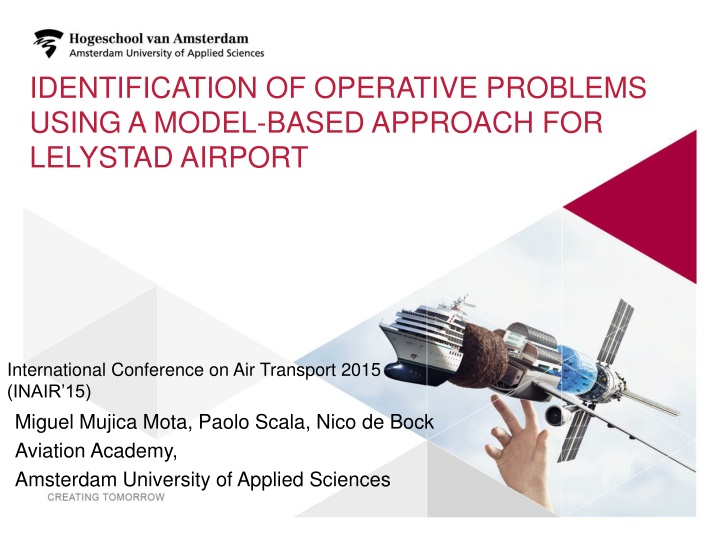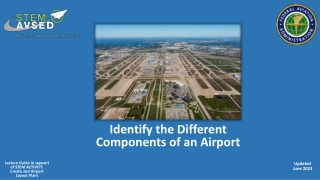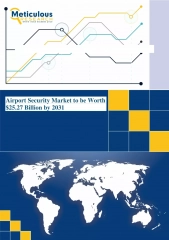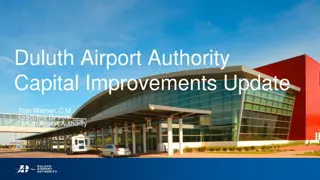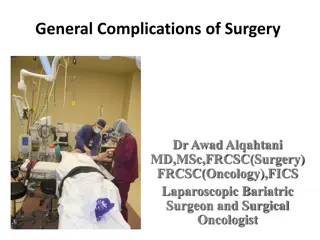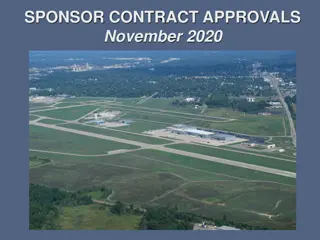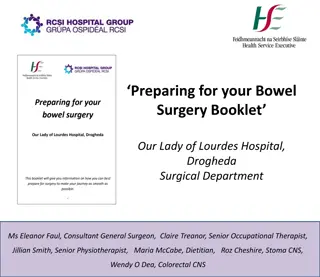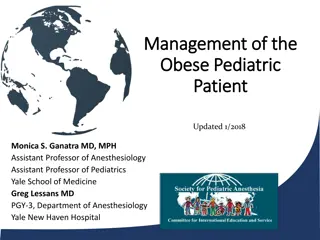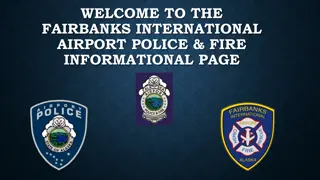Model-Based Analysis for Identifying Operative Problems at Lelystad Airport
This research study presented at the International Conference on Air Transport 2015 explores the identification of operative problems at Lelystad Airport using a model-based approach. The study aims to develop a model for assessing the future performance of the airport, addressing challenges, and objectives such as capacity analysis, identifying potential problems, and assessing the impact of uncertainty within the airport system. Various research questions focus on determining the most attractive and cost-effective configurations, potential problems, and flexibility considerations for the airport. The approach involves model-based analysis with specific restrictions and considerations related to air traffic movements, runway usage, turnaround operations, and weather data analysis.
Download Presentation

Please find below an Image/Link to download the presentation.
The content on the website is provided AS IS for your information and personal use only. It may not be sold, licensed, or shared on other websites without obtaining consent from the author.If you encounter any issues during the download, it is possible that the publisher has removed the file from their server.
You are allowed to download the files provided on this website for personal or commercial use, subject to the condition that they are used lawfully. All files are the property of their respective owners.
The content on the website is provided AS IS for your information and personal use only. It may not be sold, licensed, or shared on other websites without obtaining consent from the author.
E N D
Presentation Transcript
IDENTIFICATION OF OPERATIVE PROBLEMS USING A MODEL-BASED APPROACH FOR LELYSTAD AIRPORT International Conference on Air Transport 2015 (INAIR 15) Miguel Mujica Mota, Paolo Scala, Nico de Bock Aviation Academy, Amsterdam University of Applied Sciences 1
IMPORTANCE Development of a Multi-Airport System Including: Rotterdam Airport Eindhoven Airport Lelystad Airport 2
RESEARCH QUESTIONS FOR LELYSTAD What is the most attractive configuration? What is the best cost/effective configuration from Airport and Airline perspective? Potential problems? How to make it flexible enough? 4
CHALLENGES AND OBJECTIVES Develop a model to assess the future performance Verify that attractive PIs can be obtained by the Airport Identify potential problems for the future airport and/or airspace Identify the capacity of the system Analyze the impact of uncertainty within the system 5
APPROACH: MODEL-BASED ANALYSIS RESTRICTIONS Separation minima in the Airspace and on the Rwy Weather restrictions Speed limits Priority and sequencing rules in TA operations Separation minima on the Rwy Weather restrictions Priority and sequencing rules in TA operations Separation minima in the Airspace Weather restrictions Speed limits Separation minima on the Rwy Weather restrictions Priority and sequencing rules in TA operations Air traffic movements Number of Aircraft diverted in the Holding Pattern Flight schedule Weather data (wind and visibility) Airport system model Air traffic movements Number of Aircraft diverted in the Holding Pattern Runway usage Turnaround time Taxi-in(out) time Delay (Airspace and Ground side) Flight schedule Weather data (wind and visibility) Turnaround operations processing time Airspace model Flight schedule Weather data (wind and visibility) Turnaround operations processing time Airside model I O U T P U T Air traffic movements Runway usage Turnaround time Taxi-in(out) time Delay N P U T Runway model Turnaround model Turnaround operations processing time Turnaround time Flight schedule Weather data (wind and visibility) Air traffic movements Runway usage 9
CONFIGURATION A Gate 16 Gate 1 Configuration A: L-shaped linear terminal with partial parallel taxiway (original), runway configuration 05 8
CONFIGURATION B Gate 1 Gate 16 Configuration B: Linear terminal with parallel taxiway. Nose In-Nose out 9
CONFIGURATION C Gate 1 Gate 16 Configuration C: Linear terminal with parallel taxiway. Taxi In- Taxi Out 10
EXPERIMENTALL DESIGN RESTRICTIONS Speed limits Separation minima Segment capacity Wind direction INPUT OUTPUT Traffic volume/traffic schedule Taxi Times and delays Turn Around times/delays/total apron time Number of ground vehicles AIRPORT MODEL Runway occupation time Configuration Congestion level Monthly weather probability Bottlenecks Turn Around Times 11
RESULTS (1) 12
RESULTS (2) 13
AIRSPACE MODEL CHARACTERISTICS TAT Vehicles Separation minima(NM) ICAO - 1 fueling truck - 1 bus for boarding - 1 bus for deboarding - 2 stairs (for dual boarding) - 1 water truck - 1 cleaning truck - 1 baggage cart for baggage in and out Process Distribution Time positioning stairs Random triangular 90, 120 150 (sec) De-boarding Random triangular 5, 7.54, 9 (min) Luggage out Random triangular 5, 7, 11 (min) Aircraft speed range positioning* Random triangular 40, 60 ,80 9 (sec) Luggage in Random triangular 5, 7, 9 (min) positioning* Random triangular 40, 60 ,80 9 (sec) Fuelling Random triangular 7, 8, 9 (min) Positioning* Random triangular 4, 5, 9 (min) Cleaning Random triangular 8, 13, 16 (min) positioning* Random triangular 1, 2, 3 (min) Water service Random triangular 4, 5, 6 (min) Positioning Random triangular 1, 2, 3 (min) 14 Boarding Random triangular 8, 13, 16 (min) Headcount Random triangular 90, 120 ,130 (sec))
DESCRIPTION OF THE SIMULATION MODEL OF LELYSTAD AIRPORT TMA Lelystad Airspace (TMA) The airport is included in the Schiphol TMA 1 (Class A, Max FL 095-Min 1500 AMSL) Aircraft fly below it. Incoming(outgoing) flow of aircraft come(go) from(to) east, aircraft fly in the NW Milligen TMA (Class B, Max FL065-Min 1500 AMSL) 15
DESCRIPTION OF THE SIMULATION MODEL OF LELYSTAD AIRPORT TMA Routes in the TMA Routes for RWY 23 and 05 taken into account in the model Alders H., Presentatie en toelichting van de in het MER te onderzoeken routevarianten 16
DESCRIPTION OF THE SIMULATION MODEL OF LELYSTAD AIRPORT TMA Holding pattern procedure Holding pattern Holding pattern Aircraft are diverted into the holding patter due to congestion (number of aircraft on the ground and along the route) or disruption (crosswind) Multiple layers (stack) separated vertically by a safe distance (1000 ft) Holding pattern Entry point/IAF Used as a congestion indicator: Number of aircraft in the holding Average number of turns by Aircraft 17
DESCRIPTION OF THE SIMULATION MODEL OF LELYSTAD AIRPORT TMA Ground operations assumptions They refer to the number of gates*, Taxiing times, runway occupancy time and turnaround time In the simulation model, ground side was modeled with a server object with: Initial Capacity (number of gates) Processing time (Taxiing times, runway occupancy time and turnaround time) 18 *Schiphol Group, Ondernemingsplan Lelystad Airport , March 2014
SCENARIO&RESULTS Scenarios were based on the volume of incoming aircraft, and they take into account peak hours at Schiphol airport (Original flight schedule)* 1 scenario 2 scenario 3 scenario 60 % Original flight schedule Original flight schedule (Schiphol peak hours) 200% Original flight schedule These three scenarios were evaluated in order to test how the TMA can absorb different amount of traffic In the first scenario a limited amount of traffic was tested In the third scenario a higher volume of traffic was tested Experiments: One day of operations 10 replications *Schiphol Group, Ondernemingsplan Lelystad Airport , March 2014 19
SCENARIO&RESULTS Results obtained: Total number of incoming/outgoing aircraft Number of aircraft diverted into the holding pattern Number of turns made into the holding pattern Average number of turns made in the holding pattern for each aircraft 1 Scenario ATMs Aircraft diverted into the HP 20
SCENARIO&RESULTS Results obtained: Total number of incoming/outgoing aircraft Number of aircraft diverted into the holding pattern Number of turns made into the holding pattern Average number of turns made in the holding pattern for each aircraft 2 Scenario ATMs Aircraft diverted into the HP 21
SCENARIO&RESULTS Results obtained: Total number of incoming/outgoing aircraft Number of aircraft diverted into the holding pattern Number of turns made into the holding pattern Average number of turns made in the holding pattern for each aircraft 3 Scenario ATMs Aircraft diverted into the HP Number of turns into the HP 22
SCENARIO&RESULTS Results from scenario 3 (High volume of incoming aircraft) In average 9 aircraft diverted into the holding pattern, 41% of the cases betweeen 5 and 15 aircraft delayed into the holding pattern Average number of turns made in the holding pattern for each aircraft (1,33), 11% of the cases 1 turn and 89% 2 turns 23
SURFACE RESPONSE Response surface with Apron s entering mode fixed at level 1 (Left-Right) 24
SURFACE RESPONSE Response surface with Apron s entering mode fixed at level 2 (Center-Out) 25
LESSONS LEARNED&FUTURE WORK GROUND The stability of the system impacts the performance on the airport Taxi-in Taxi-out (Config. C) has good potential when using an efficient allocation algorithm if not segregated operation will be more stable. Airspace We could identify tresholds for good performance of the system Scenario 1 and 2 are not congested Scenario 3 starts to be congested Capacity limit of the system is found between scenario 2 and 3 26
IDENTIFICATION OF OPERATIVE PROBLEMS USING A MODEL-BASED APPROACH FOR LELYSTAD AIRPORT THANK YOU FOR YOUR ATTENTION! Miguel Mujica Mota, Paolo Scala, Nico de Bock (a)Aviation Academy, Amsterdam University of Applied Sciences
